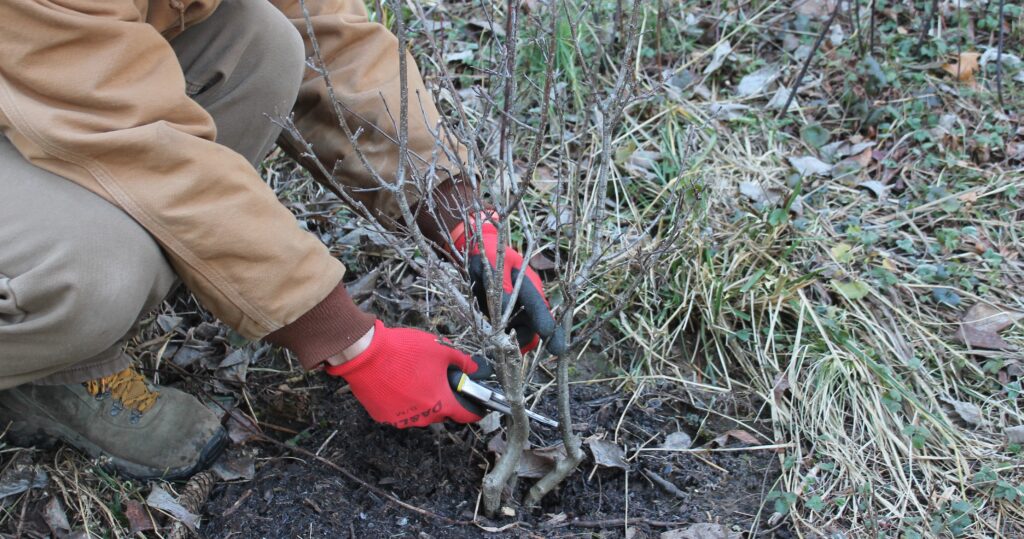There’s a common myth that gardens don’t require work in the winter because many plants are dormant. In reality, the “off season” is the perfect time to check off several essential tasks. Here are six winter gardening tasks to set you up for an easier, more successful springtime.
Prune away dead, diseased, and crossing branches
Winter is the best time to prune your woody plants. This is the time when many branches are bare, making it easier to see any dead, diseased, or crossing wood. This is also the time to assess the branching structure of your trees and shrubs and prune for improved shape and appearance. Make pruning a top priority for your garden during the winter. It benefits overall woody plant health, adds organic matter back into the soil when composted, and is a great way to get outside and active.

Remove invasive plants
Don’t forget about the introduced plant species that cause more harm than good in our landscapes. Remove these invasive plants now to reduce their impact on the land.
There are many woody vines, trees, and perennials that you can manage throughout winter, when other plants are dormant and these invasive plants are easier to access. Some easy plants to spot in winter include lesser celandine, autumn olive, invasive grasses, and invasive vines such as bittersweet and honeysuckle vine. Address these plants during the winter gardening season to save time and money in spring. And in winter it is easier to wear long sleeves to protect yourself from thorns!
Monitor plant health
Don’t forget winter plant care. While we admire the beauty of winter landscapes, winter gardening is as important as gardening during the growing season. This includes watering (yes, plants do need water in winter) and scouting for problems like bud damage and frost heave, which can uproot small plants.
Weather patterns are becoming more unpredictable in our changing climate. This can lead to drought during periods that we typically receive rain and unexpected spring-like temperatures in winter. Check your plants for signs of drought stress and plan to water the garden after any three-week period with warm weather and no significant rainfall.
Additionally, unusually warm winter temperatures may cause premature bud break, but a hard freeze later in the season will likely damage these buds or new foliage. Look for blackened buds and young leaves that have fallen off prematurely. Perform early-spring pruning to help stimulate new growth, masking this damage.
And finally, the winter freeze-thaw cycle can push small plants, especially plugs, out of the soil. Periodically check new garden beds and re-plant any plugs whose roots have become exposed by frost heave.
Check plants for insect and animal damage
Animal Damage
Woody plant damage from deer and rodents increases during the winter months, when food and water are scarce. Repeated animal damage harms the overall health, form, and function of woody plants, but this damage often goes unnoticed until it’s too late. Look for signs of deer and rabbits, like stripped bark and chewed branches. Voles, which are little mice-like animals, are especially problematic. They eat new bark at ground level which can kill young trees. Catch these problems early, or better yet, proactively protect vulnerable trees and shrubs with fencing or repellents before damage occurs.

Insect Damage
Winter is a good time to scout for any new and emerging pests that were overlooked during the growing season. Pay attention to discoloration or insect residues, deformities or holes in leaves, and chewed bark or roots. Don’t forget that many insects are beneficial and are a sign of a healthy ecosystem. Use the principles of Integrated Pest Management (IPM) to make informed decisions about if, how, and when to treat potential problems.
Inspect areas for damage from vehicles, soil compaction, and stormwater issues
Look for small things that translate to big problems during the growing season, particularly damage from vehicles, soil compaction, and stormwater issues.

It is much easier to see the ground in the winter garden than when plants are actively growing. Corners of garden beds and edges of driveways are common sites of damage from vehicles and soil compaction. Look for tire treads or footprints and poke the soil to check for hardness that can’t be attributed to freeze. During periods of rain, check for wet spots that just can’t seem to dry out. If this lasts more than three days, it could be a sign of stormwater issues.
Need help with next steps? GreenWeaver can offer creative stormwater solutions to repair damage and mitigate future problems.
Make a plan for next year
After a busy growing season, welcome a period of rest and plan for next year. Winter is the perfect time to sit down, reflect on what went well during the season, and think of opportunities for improvement. If your garden needs more winter interest, incorporate new plants or work with a designer to create an ecologically functional and beautiful landscape plan. Mark bare areas to fill, plants to divide, and decide where to transplant plants that could benefit from a new location. Then write it all down so you don’t forget your plans in the springtime!
Not ready to jump back into the garden? Hire a gardener and leave the hard work to us!

